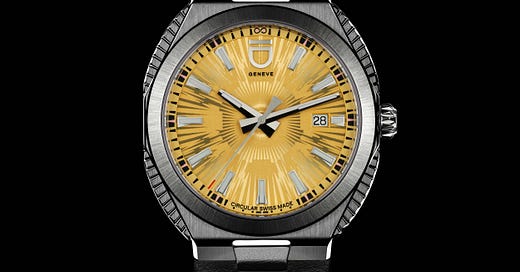The Fourth Wheel, Issue 90
Ask Me Anything: Do we really want sustainability? Is time up for integrated bracelet designs? What are the best case materials? And why are minute repeaters so expensive?
Hello and welcome back to The Fourth Wheel, the weekly watch newsletter that is answering your questions. Thank you to everyone who wrote in - we have some belters this week. Provocative ones, simple ones, serious ones and sarcastic ones. In fact, I received too many to answer in one email - if yours isn’t answered below, I will do a special bonus session next week!
The Fourth Wheel is a reader-supported publication with no advertising, sponsorship or commercial partnerships to influence its content. It is made possible by the generous support of its readers: if you think watch journalism could do with a voice that exists outside of the usual media dynamic, please consider taking out a paid subscription. You can start with a free trial!
Here’s a little taste of what you might have missed recently:
Where Are All The Risk-Takers?
An Unfiltered Response To LVMH Watch Week
What Was The Greatest Era Of Chronograph Watchmaking?
What To Expect In 2024
The Best And Worst Watch Brand Websites
I forgot to give you a leap-year fact last week, as promised in Issue 88. So here are two:
You might know that in French, leap years are called ‘bissextile’ years. Which sounds a lot more suggestive than it really is. It comes from the Latin bis sextus or ‘double sixth’, which still makes no sense at all until you understand that the Romans, who first figured out the need for additional days to make the calendar balance, decided to double up on February 24th, the sixth day before March 1st. Why this day in particular is hard to explain - suffice to say that for centuries the Julian calendar was, to use a technical term, a bloody mess.
I bet you didn’t know that in addition to February 29th, there has been at least one February 30th. In 1712, as it transitioned from the Julian to Gregorian calendars, Sweden decided not to omit a block of consecutive days, but to miss out all leap days over a 40 year span. It didn’t work, because as Wikipedia drily puts it, they were ‘diverted’ by the start of a war.
Ask Me Anything
Has anyone ever said to you, or within earshot: “I wish my watch was more sustainable”? – Robin Swithinbank
Stirring the pot – I approve. No, as Robin is very well aware, this has never happened. CEOs are very fond of telling us that customers are demanding more sustainable products, but oddly the actual customers then seem perfectly happy to buy the same watches they’ve always bought1.
If you ask people if they care about saving the planet, of course they’ll say yes, but if you ask them how much of a premium they would pay for a watch that was actually demonstrably sustainable, you’ll get a much wider spread of answers. I do wish my watches were more sustainably produced but I must be honest, it hasn’t stopped me buying them. I’m not dismissing people’s attitudes as pure virtue-signalling; I do believe people care about the planet, but when it comes to altering their purchasing habits, whether for food, cars, clothes, watches or anything else, sustainability has to contend with so many other factors. Price, brand, practicality, quality, design – they all jostle for priority. Or to put it another way, a sustainable alternative can’t compromise on any of the above if it’s to be a true alternative. And people need to really see the connection between what they buy and the impact it has. Anyone intent on changing watch buyers’ minds needs to make a much stronger connection between what’s on your wrist and the environmental damage caused by mining and refining metals, producing industrial dyes, solvents, plastics, gemstones and all the rest. Out of sight is out of mind. Unfortunately, I think the bombardment of messaging necessary to get the point across would run the risk of appearing excessively negative, and turn people off – which is why most corporate social responsibility focusses on positive messaging, like saving some charismatic animals or a beautiful habitat. TL;DR - sustainability is important, it’s a hard problem to fix, and the incentives to fix it don’t seem to be aligned across the industry.
What watch media excites you these days? – Cole Pennington
Great question, and what a gilt-edged opportunity to offend so many prospective employers. I am excited by an editorial agenda that doesn’t simply follow new releases, so despite everything I still think a lot of what Hodinkee publishes is superior to other specialist media. I have a lot of time for the mainstream publishers, like the NYT and Financial Times, who still make space for stories about watch culture and individuals within the watch world who will never repay that coverage with advertising revenue. I am excited that there is currently quite a rich seam of industry journalism that is less subservient than ever, coming from places like Bloomberg, BoF, Miss Tweed, the NZZ, and the WSJ. I think WatchPro does occasionally fall into this category but as the industry’s dedicated trade title, misses the opportunity to invest in agenda-setting journalism, preferring quick-hit opinion pieces or fluffy news coverage. An independent trade publication like that should be able to campaign, to lead, to demand clarity and action and stir things up.
Oh, so much ‘legacy media’. Aren’t I excited by what the kids are doing? Well…
Keep reading with a 7-day free trial
Subscribe to The Fourth Wheel to keep reading this post and get 7 days of free access to the full post archives.





